|
To Recognize
Bugs |
|
 |
 |
Body shape
A typical bug shows an oval,
more or less flattened shape (Pentatomidae, Cimicidae for example). Depending
on the mode of life there exist numerous variations with a bewildering
range of shapes and colours from a nearly rounded body (Plataspidae) to
mosquito-like shape (Empicoris).

typical:Pentatoma
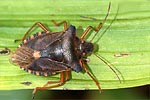 |
spherical:Coptosoma
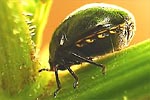 |
mosquito-like:
Empicoris
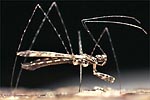 |
 |
 |
Wings
Wings can be fully
developed (macropterous), reduced (brachypterous) or totally missing (apterous).
The forewings are divided in a tough (sclerotisized) front part and a membranous
hind part. That gives rise to the name Heteroptera. Hindwings are membranous
and lie folded beneath the forewings when in rest. During flight, fore
and hindwings are coupled together.

flying: Carpocoris
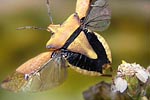 |
apterous:Cimex
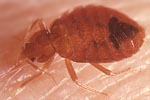 |
brachypterous:Dimorphopterus
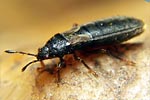 |
 |
 |
Scutellum
A triangular plate,
the scutellum, lies between the bases of the forewings. It is often enlarged
and in extreme cases it covers the whole abdomen (Scutelleridae, Plataspidae
for example). In contrast, the scutellum of beetles is small, often very
small.

normal scutellum
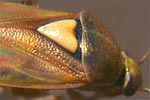 |
extreme scutellum
form
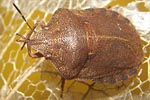 |
typical beetle
scutellum
 |
 |
 |
Stinging and sucking
All bugs have a specialised
rostrum (beak), which arises from the front of the head and which lies
directed backwards under the body when not in use. With the rostrum they
can pierce plants and animal prey, inject digestive secretions and suck
the plant sap or the liquid compounds of its prey.

stinging rostrum
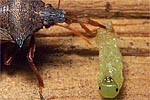 |
resting rostrum
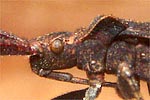 |
mouthparts of
a beetle
 |
 |
 |
The stink glands of bugs
Virtually all bug species
have stink glands, which produce a defensive secretions which consists
of long-chain alcohols and aldehydes. It is an effective repellent against
predators, smelling bad for people. It is smeared with the legs on enemies
or directly sprayed out of the openings, which lie at each side of the
metasternum in the adults and on the back of the abdomen in the nymphs.
 |
 |
Giants and dwarfs
Body length in bugs varies
from about 1 mm (or less) in some terrestrial families (Dipsocoridae for
example) up to 60 mm (or more) in the rapacious aquatic forms (Nepidae,
Belostomatidae).

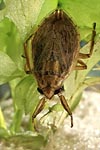  |
giant
water bugs (Belostomatidae) from Japan and Malaysia.
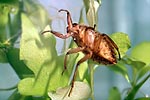  |
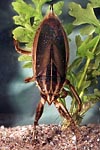 |
 |
 |
|